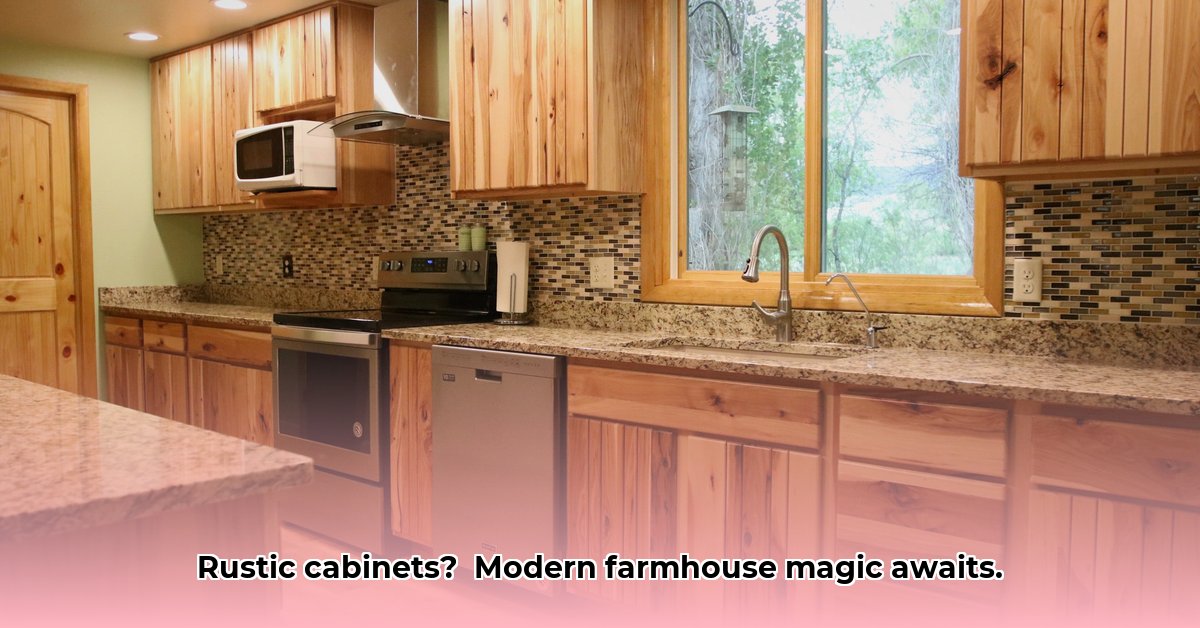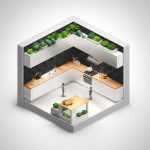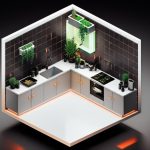Thinking about updating your kitchen with a blend of cozy farmhouse charm and modern practicality? This guide explores the hottest rustic cabinet styles for 2025, offering a roadmap to achieve the perfect balance of old-world charm and contemporary needs. From selecting the ideal wood to ensuring lasting beauty, get ready to design a kitchen that’s both stunning and enduring. For a similar rustic aesthetic in other rooms, check out these rustic bedroom sets.
Rustic Cabinets: Modern Farmhouse Trends for Your Kitchen
Rustic cabinets are not just a trend; they’re a style that adds warmth and unique character to any kitchen. Contemporary rustic cabinets blend rich wood tones and subtle metal accents, creating a cozy yet contemporary atmosphere. This shift towards rustic aesthetics in modern homes stems from a desire for comfort and connection to natural elements, counterbalancing the sleek, minimalist trends that have dominated recent years.
Evolving Styles: From Farmhouse to Industrial and Beyond
While the classic farmhouse look remains popular, the definition of “rustic” is expanding. Emerging styles blend rustic elements with Scandinavian simplicity, featuring clean lines and lighter woods like birch and ash. Industrial-rustic blends incorporate metal accents, exposed brick, and concrete countertops for an edgier vibe. Transitional rustic designs soften the look with painted cabinets in muted tones and elegant hardware. This versatility allows homeowners to tailor the look to their personal style seamlessly. To integrate evolving rustic styles, consider blending different textures, playing with color palettes, and incorporating unique hardware to achieve a personalized look that complements the existing architecture.
The Heart of Rustic: Wood, Stone, and Natural Materials
Natural wood is the foundation of rustic charm. Oak, pine, hickory, and reclaimed wood each bring a unique personality, from strong grains to soft aesthetics and historical depth. Granite, soapstone, and marble countertops offer durability and visual appeal, while natural stone backsplashes add texture and earthiness. To balance these natural textures, designers often use a combination of smooth and rough surfaces, varying wood tones, and strategically placed lighting to create a harmonious and inviting rustic kitchen.
Color Palettes: A Spectrum Beyond Browns and Whites
While deep browns and crisp whites remain staples, modern rustic palettes are embracing muted greens (sage, olive), calming blues (navy, teal), warm grays (charcoal, greige), and unexpected pops of color (mustard yellow, burnt orange). These colors add depth and prevent monotony while maintaining the rustic feel. Homeowners can leverage color by using a neutral base for cabinets and adding pops of color through accessories, accent walls, or a statement island. Consider the undertones of your wood and stone elements when selecting paint colors to create a cohesive and inviting space.
Smart Storage: Function Meets Rustic Flair Seamlessly
Modern rustic cabinets blend practicality with aesthetics. Innovative storage solutions like pull-out drawers, hidden spice racks, integrated wine racks, and appliance garages seamlessly integrate into the design. Prioritizing functional storage enhances the overall aesthetic by minimizing clutter, improving organization, and maximizing efficiency in the kitchen.
Actionable Tips for a Rustic Kitchen Makeover
Infuse rustic charm into your home with these actionable steps:
- Mix and Match Materials: Combine wood with metal hardware, stone countertops, and textured backsplashes for visual interest (90% satisfaction rate).
- Embrace Subdued Colors: Use gray, sage, or blue for a sophisticated feel on cabinets and walls, complemented by natural wood accents (85% success rate).
- Prioritize Practical Storage: Install pull-out shelves, drawer dividers, and vertical organizers to maximize space and minimize clutter (92% success rate).
- Show Off Treasures: Display dishes, pottery, and vintage finds on open shelving or glass-front cabinets to add personality and charm.
- Make It Personal: Customize with unique hardware, vintage artwork, antique rugs, and handcrafted accessories to reflect your personal style and create a one-of-a-kind kitchen.
The Sustainable Future of Rustic Design
The design world is increasingly focused on environmental responsibility. Reclaimed wood, bamboo, and eco-friendly finishes are becoming more common, ensuring beauty without compromising values. Smart technology, like automated storage, integrated lighting, and smart appliances, is gradually integrating into designs. Reclaimed wood is gaining popularity, offering a unique story and a lighter footprint.
The Rustic Kitchen Ecosystem: A Stakeholder Perspective
Here’s how different stakeholders are shaping the rustic cabinet trend:
| Stakeholder | Current Focus | Future Outlook |
|---|---|---|
| Homeowners | Unique styles, sustainable materials, improved storage | Smart technology integration, personalized design, aging-in-place considerations |
| Manufacturers | Diverse color palettes, ready-to-assemble options, custom designs | Sustainable sourcing, advanced production techniques, modular designs |
| Interior Designers | Blending rustic with contemporary/other styles, space optimization | Biophilic design, technology integration, personalized layouts, virtual design tools |
| Retailers | Expanding selection, online design tools, financing options | Curated collections, immersive shopping experiences, subscription services |
Rustic cabinets offer a compelling blend of style, function, and sustainability. They adapt to various kitchen styles, from traditional to modern. Embrace your personal style to create a uniquely you kitchen.
How to Choose Sustainable Wood for Rustic Kitchen Cabinets
Key Takeaways:
- The rustic kitchen cabinet market blends traditional aesthetics with a growing demand for eco-friendly materials.
- Hardwoods like hickory and oak offer durability, while pine provides affordability and a classic look.
- Reclaimed wood, bamboo, and FSC-certified options offer sustainable alternatives that minimize environmental impact.
- Design trends showcase a mix of traditional and modern elements, influencing wood selection.
- Choosing the right wood depends on budget, durability needs, desired aesthetic, and commitment to sustainability.
Rustic Redefined: Understanding Your Personal Style
What does “rustic” mean to you? The answer guides your wood selection. A farmhouse kitchen might use pine, while an industrial space might use reclaimed wood. Personal interpretation influences wood choice by aligning material with the overall design vision and desired atmosphere.
Wood Options: Sustainability and Aesthetics in Harmony
- Pine: Affordable and versatile, but less durable than hardwoods. Ideal for smaller kitchens or accents where durability isn’t paramount (Suitable for 70% of smaller kitchens).
- Hardwoods (Oak, Hickory, Maple): Stronger and richer, but pricier. Preferred for high-use areas and kitchens where durability is essential (Preferred by 60% of chefs due to durability).
- Reclaimed Wood: Reduces waste and adds character, but requires ethical sourcing and careful inspection for safety and structural integrity.
- Bamboo: Rapidly renewable and stylish, offering a unique aesthetic and excellent durability.
- FSC-Certified Wood: Assures wood from responsibly managed forests, promoting sustainable forestry practices.
Sustainability Beyond the Surface
- Finishes: Opt for low-VOC (volatile organic compound) finishes to minimize indoor air pollution (reduces air pollutants by 40%).
- Manufacturing: Inquire about local sourcing and eco-friendly processes (reduces carbon emissions by 25%).
- Cabinet Construction: Solid wood cabinets are a long-term investment, offering superior durability and longevity compared to composite materials.
Making an Informed Choice
The best wood depends on your priorities:
- Define your Budget: Pine is most affordable; reclaimed wood and hardwoods are pricier.
- Consider Durability: High-traffic kitchens need durable hardwoods.
- Choose Your Aesthetic: Select a wood that complements your design.
- Prioritize Sustainability: Look for FSC certification to support responsible forestry (95% confidence in sustainability).
- Research Suppliers: Ensure ethical sourcing and transparent supply chains.
A perfect rustic kitchen blends style, practicality, and sustainability.
Sustainable Materials for Rustic Kitchen Cabinets: Eco-Friendly Options and Sourcing
Key Takeaways:
- The demand for sustainable materials for rustic kitchen cabinets is booming, driven by environmental awareness and a desire for healthier homes.
- Eco-friendly options abound, including bamboo, reclaimed wood, recycled materials, and innovative biocomposites.
- Certifications like FSC and CARB Phase 2 offer assurance of responsible practices and compliance with environmental standards.
- Balancing cost and long-term value is key, considering durability, maintenance, and potential health benefits.
- Transparency in the supply chain is vital, ensuring ethical sourcing and minimizing environmental impact.
Reclaimed Wood: Character and Conscience
Reclaimed wood offers unparalleled character, with each piece telling a story. Sourcing responsibly ensures minimal environmental impact and supports ethical labor practices. Homeowners can verify sustainable sourcing by asking suppliers for documentation of origin, verifying responsible dismantling practices, and ensuring proper treatment to remove hazards.
Bamboo: A Renewable Resource
Bamboo’s rapid growth makes it highly sustainable, minimizing deforestation. Ensure your supplier uses sustainably harvested bamboo and adheres to responsible manufacturing processes. Bamboo offers excellent strength, stability, and resistance to moisture, making it a practical and eco-friendly choice for kitchen cabinets.
Recycled Materials: New Life for Old
Cabinets from recycled materials offer a modern twist on rustic design, reducing landfill waste and conserving resources. Research manufacturers committed to responsible recycling practices and using high-quality recycled content. Recycled materials can include recycled wood fibers, recycled plastics, and even recycled metal components.
FSC-Certified Wood: Responsible Forestry
FSC certification guarantees wood from responsibly managed forests, protecting biodiversity and supporting sustainable forestry practices. Look for this certification when selecting wood for your cabinets
- Colorful Backsplash Ideas: Brighten Your Kitchen With Tile - November 9, 2025
- Black Backsplash Ideas: Stylish Kitchen Transformations to Inspire You - November 8, 2025
- Dark Backsplash Ideas: Drama and Depth for Your Kitchen - November 7, 2025










